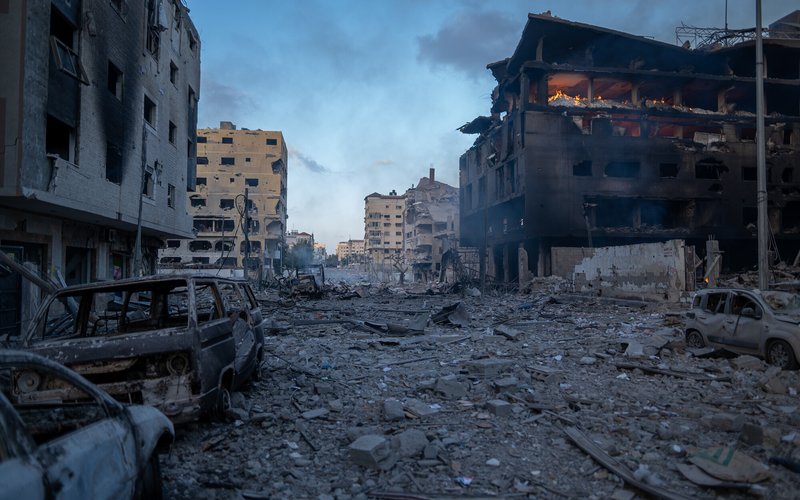Oxfam partners are trying to get food, clean water, and medicine to desperate families. Here’s the latest, and what you can do to help.
Getting humanitarian aid into Gaza is a complicated mess—but it shouldn’t be.
With a fragile ceasefire agreement strained by continued violence, Oxfam and other aid groups remain ready to scale up to deliver more food, clean water, and medicine to millions of Palestinians in need. Despite overwhelming needs, the Israeli government is still allowing just a small fraction of the humanitarian aid needed into Gaza.
“There remains appalling and preventable levels of hunger in Gaza,” said Marta Valdes García, Oxfam’s Humanitarian Director. “Israel is allowing far too little aid to enter, even as it continues to actively block aid requests from dozens of well-established humanitarian agencies.”
Oxfam is calling for unhindered access to vital aid in Gaza. We stand ready to scale up the delivery of humanitarian aid once access is granted.
Gaza’s urgent need for increased aid delivery
Palestinians in Gaza remain in desperate need of humanitarian aid as winter weather continues to worsen conditions. The most pressing needs include food and healthcare and shelter, as well as water, sanitation and hygiene services (WASH) including menstrual products and waste management services.
- The latest global hunger report showed that 1.6 million people in Gaza are expected to face severe hunger through next April. In October and November, 100,000 people faced starvation.
- Winter is bringing flooding and misery to those in need. Millions of people have no safe shelter, and more than 630,000 children between the ages of 11 and 17 need winter clothing.
- While limited food and other goods have become more available in some local markets, they remain largely unaffordable for many Palestinians. Presently, no child in Gaza is getting adequate food and nutrition.
Children are particularly at risk. More than 100,000 children under five, as well as 37,000 pregnant and breastfeeding women, will need treatment for acute malnutrition.
What is the current situation on aid entering Gaza?
Some aid and commercial supplies are entering Gaza, which is contributing to limited improvements in the humanitarian situation in some communities. But the volume is still far below what is needed to meet urgent needs.
Since the current ceasefire began on October 10th, Israeli authorities continue to arbitrarily reject scores of shipments of life-saving assistance into Gaza. Almost $50 million worth of food, water, tents, and medical supplies is still being held up at border crossings and warehouses. Oxfam alone has $2.5 million worth of aid sitting in Jordan, including 4,000 food parcels.
Nevertheless, some humanitarian organizations have partially resumed operations in parts of the Gaza Strip and begun scaling up the delivery of aid and services, but still at levels far short of capacity and need.
- As of December 17th, UN partners assisted more than 145,000 households with monthly food parcel distributions—at most covering only 50-75 percent of their daily caloric needs for about 10 days.
- Since October, UN partners have distributed more than 250,000 pieces of winter clothing for children—far short of overall need.
- In 2025, 90,000 children facing acute malnutrition were admitted for treatment, more than double of the 40,000 cases recorded last year.
What is Oxfam doing to help aid get into Gaza?
Oxfam and the UN are doing everything we can, through partners, to deliver life-saving aid. Prior to the ceasefire, Oxfam worked closely with our partners in Gaza to reach more than 1.2 million people with humanitarian assistance. Since October 2023, our water, sanitation, and hygiene programs have reached over 800,000 people.
Immediately following the ceasefire, Oxfam is sourcing materials within Gaza in order to scale up its work to assist partner organizations, people displaced by the conflict, and those on the move and choosing to return to their homes. This includes the recent installation of 600 latrines in southern Gaza, a major accomplishment.
With your support, Oxfam and its partners plan to reach 500,000 people as soon as we’re able. Over the next three months, our local partners will focus on a range of emergency interventions including:
- Food
- Clean water
- Access to hygiene items, including menstrual products
- Rehabilitation of water and sanitation systems and wells
- Solid waste management
- Training and supplies for home gardens to help people grow vegetables
- Support for survivors of gender-based violence
The announcement of an agreed first-stage ceasefire in Gaza is welcome news after two years of fighting—as is news of the release of Israeli hostages and unlawfully detained Palestinian prisoners.
The ceasefire agreement promised unimpeded humanitarian assistance, and we urgently need full access for all qualified humanitarian organizations.
"Nothing other than complete access to Gaza to deliver aid at scale can alleviate the conditions that people have been forced to live in," said Bushra Khalidi, Oxfam in the Occupied Palestinian Territory and Israel policy lead.


